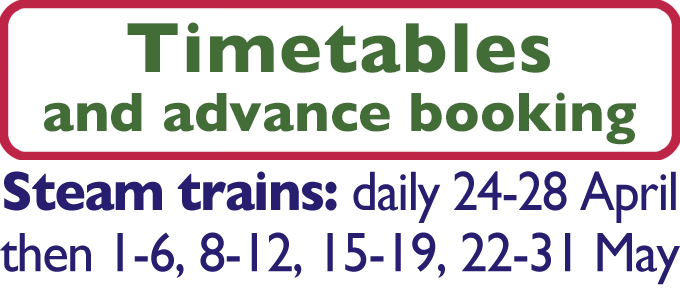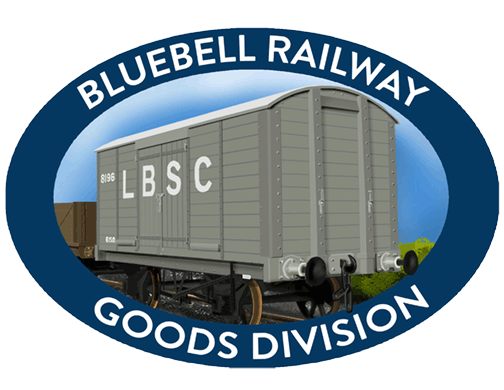Our new arrivals 4228 (originally B783270) and 4224 (originally B783912) have been bought by a private party primarily for diesel component storage, but also intended for use in the heritage fleet as well, as part of our BR-era Goods Train.
A little bit of history of the two vans
Both B783912 and B783270 were built at Wolverton Works in 1962 to Diagram No. 1/217 under Lot Nos. 3391 and 3392. They entered traffic for general use. In 1982, both vans were rebuilt at Horwich Works, their brakes were converted from Vacuum to Air Brakes and modern suspension.
They ended their mainline careers at MOD Marchwood and in late 2024 were surplus to requirements, originally destined for scrap with all other wagons at MOD Marchwood.
Thankfully, with help from the National Wagon Preservation Group, 10 of these wagons made it in preservation with B783912 and B783270 now destined for the Bluebell Railway.
Vanwides to VEAs
 By the late 1950s BR had introduced a number of different vacuum-braked pallet van designs but most had only been built in relatively small numbers for specific customers or, as in the case of the cupboard-door Palvans built from 1953 to Diagram 1/211 (see Bluebell's B772972), had proved to be something of a failure due to their poor riding characteristics at speed. Furthermore, the large cupboard-doors of these Palvans were often awkward and in some places impossible to operate, such as at the Manchester Haulage & Warehousing Co. building in Trafford Park where the customers premises lay extremely close to the rail siding with very limited clearance. To obviate this problem both the LMS and the LNER had designed vans with sliding doors and this style was adopted by BR for its final, and most successful, vacuum-braked pallet van, the Vanwide.
By the late 1950s BR had introduced a number of different vacuum-braked pallet van designs but most had only been built in relatively small numbers for specific customers or, as in the case of the cupboard-door Palvans built from 1953 to Diagram 1/211 (see Bluebell's B772972), had proved to be something of a failure due to their poor riding characteristics at speed. Furthermore, the large cupboard-doors of these Palvans were often awkward and in some places impossible to operate, such as at the Manchester Haulage & Warehousing Co. building in Trafford Park where the customers premises lay extremely close to the rail siding with very limited clearance. To obviate this problem both the LMS and the LNER had designed vans with sliding doors and this style was adopted by BR for its final, and most successful, vacuum-braked pallet van, the Vanwide.
In 1959 six standard BR Vanfits were fitted with new sliding-doors and, following trials in general merchandise traffic, this new Vanwide design went into production with some 2,000 being built at Wolverton Works between 1961 and 1963.
The introduction of the TOPS computer system in 1972 saw the Vanwides coded VWV and although their use in general traffic began to decline as the decade progressed, they remained a common type, particularly in military traffic carrying a wide range of items including grenades, mortar bombs, artillery shells, uniforms, cans of paint, drums of lubricating oil and spare tyres on behalf of the Ministry of Defence.
At the behest of the MoD some 560 Vanwides had their plain bearings replaced with roller bearings, obviating the need for each wagon to be inspected before every loading with ammunition or explosives, which was a time consuming safety requirement with plain bearing wagons to avoid the possibility of a hot axlebox during transit. To help distinguish the various Vanwides in MoD traffic, those modified with roller bearing were recoded VEV, while those that retained plain bearings remained VMVs.
BR's decision to gradually transfer its wagonload business to the air-braked network posed a problem for the MoD since the severe curvature of the sidings at many military depots meant that they could not accept the new longer air-braked vans that BR had built in the early 1970s. Consequently in 1977, 50 VEVs were renumbered in the range 230000-230049 and recoded VEA, after having been air-braked and fitted with FAT 19 BR friction-link suspension at BREL's Ashford Works which allowed for their operation up to 75mph.
With the rebuilds proving a great success, a further 500 Vanwides were similarly converted between 1981 and 1984 becoming 230050-230549, this task being split between the BREL works at Horwich and Shildon. Modified prior to the introduction of Railfreight's red and grey livery, the first 50 VEAs had been turned out in maroon, but this colour quickly faded and by 1985 they had all been repainted red and grey matching the later VEAs.
In 1985, 25 VEAs were experimentally fitted with an internal alarm but the only external alteration in their appearance appears to have been a change of TOPS code from VEA to VFA. Like the VEVs, the VEAs carried a wide range of military stores and equipment to numerous destinations, including MoD installations and local goods depots, across the country, although they were most commonly to be found working from the Royal Ordnance Factories at Chorley and Glascoed.
In 1987 Railfreight adopted a new dark grey and yellow livery for its wagon fleet but only a handful of VEAs had been repainted in the new colours prior to the type being withdrawn from revenue service in the early 1990s, after which many found their way into internal military use at locations such as Longtown and Marchwood.
Type: Vanwide Diag 1/217 (VEA)
Built: 1962, Wolverton Works
Original number: B783912
Later numbers: 230307, MoD WGB 4224
Length: 17' 6' over headstocks
Weight: Later 8.7 tonnes
Load: 12 T
Preserved: March 2025
To Bluebell: 23 May 2025
Owner: private










